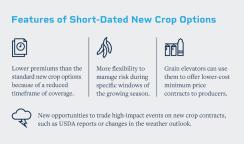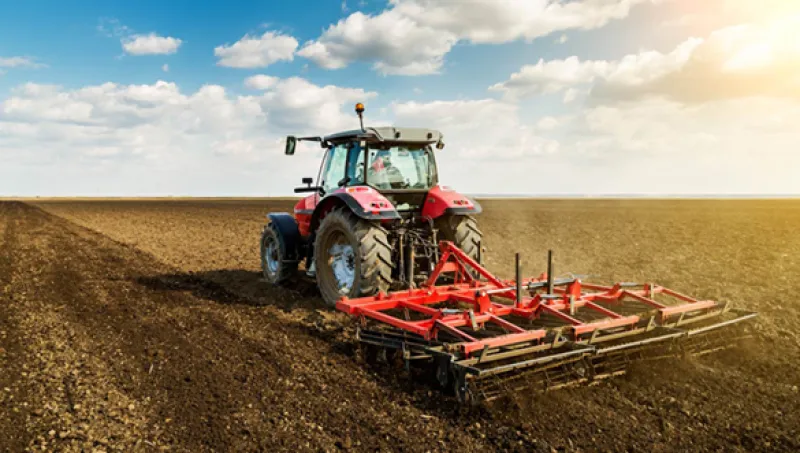By Bruce Blythe, for CME Group
AT A GLANCE
- Grain producers enter a third pandemic-era planting season with some traditional and new risks ahead, highlighting the need for risk management tools
- Short-dated new crop options offer more flexibility in marketing decisions for farmers, say introducing brokers
The past two years, however, were hardly business as usual, as the COVID-19 pandemic roiled markets and economies and exposed farmers’ traditional grain options-based hedging strategies as not always well-suited for fast-moving times.
As another growing season looms, CME’s short-dated new-crop options have emerged as a handy tool to help farmers, as well as grain processors and others in agriculture, lower hedging costs and help protect against “Black Swan” disruptions, as well as more predictable events, such as USDA crop reports, said Jack Hainline, Risk Advisor at Advance Trading Inc.
“For farmers, the past two years have really illustrated the need for greater flexibility in marketing decisions,” Hainline said.
“A lot of producers that did not hedge with options made emotional decisions when the market tanked after Covid hit in 2020 that they normally wouldn’t have made,” Hainline said. “Not having price floors in place with an option hedge can cause that sort of panicked reaction. The counter effect happened when grain prices rallied after markets recovered leading into the spring of 2021.”
As we head into another planting season in the U.S., we discussed with Hainline and Matt Huston, a broker with New Frontier Capital Markets, three main risks to watch for producers during the spring.
Brazil’s Second Crop
Brazil’s second, or “safrinha,” corn crop, which accounts for about three-fourths of the country’s annual corn production, is planted during the U.S. winter and harvested between May through August. Weather and other factors that affect the safrinha crop outlook can influence U.S. grain prices, presenting potential short-dated options-based hedging opportunities for U.S. farmers well before they put their seeds into the soil.Read more about short-dated new crop options.
This year, persistent drought has slashed harvest prospects in southern Brazil and other key crop areas, sending corn futures rallying above $6 a bushel to seven-month highs. Environments like this can cause a disconnect between old-crop and new-crop futures, meaning hedging new-crop production using standard put options that derive value from old crop futures won't serve as an adequate hedge, Hainline said.
For example, U.S. farmers in January seeking to hedge the 2022 fall harvest might be inclined to buy a July put option to protect unhedged production. However, a scenario in which safrinha crop prospects shrink while the U.S. planting outlook expands creates a potential grain market “inversion” where July futures rally while December prices drop.
“If the producer buys a standard July put option, it does them no good in this environment,” Hainline said. “They need to protect against the ‘future’ they are actually delivering against. This is one good use-case illustrating why short-dated options were introduced. In such a scenario, a farmer would be better served with the July short-dated put option, because its value is derived from December 2022 futures, as opposed to the July 2022 contract.”
Early indications are that producers are adopting this approach in 2022. Short-Dated New Crop options open interest – the number of outstanding contracts – was already over 100,000 in late February, while February average daily trading volume was almost double 2021.
Spring Weather
More traditional risks like spring weather during the early growing season in the United States can pop up at any time, and disappear almost as quickly. It’s another reason short-term coverage through options can be useful.
“If it's a wet spring, the farmer’s crop ‘rotation’ may change, meaning the acreage breakdown of the crops they end up planting may change,” Huston said. “Farmers don’t like making cash sales to grain elevators or end-users before they know exactly what they put into the field and how it went into the field during planting season.” With short-dated new-crop options, “you can cover your planting window” with greater precision, and do so at a lower cost,” he added.
Early indications from the U.S. drought monitor show some level of drought in growing regions of the western U.S. Historically, that is a typical pattern for a La Niña year, and dry conditions could spread to the Midwest by spring affecting some of the higher production areas for corn and soybeans.
Huston also highlights how short-dated options offer an advantage over standard options in the winter or early spring due to lower premiums.
Premiums for short-dated new-crop options are typically about 30% cheaper compared to standard November soybean and December corn options.
For example, a May short-dated new-crop corn put option with a $5.40 strike price (and linked to December corn futures), could have been purchased in late January at a premium of 10 cents. The standard put option had a premium of 37 1/2 cents, meaning the short-dated version was 27 1/2 cents cheaper.
By purchasing the $5.40 short-dated put, a farmer could have effectively established a price floor for 5,000 bushels of corn at $5.30 ($5.40 minus the 10-cent premium). The put expires April 22, but the buyer in this example was not seeking protection beyond that date.
“If futures drop under $5.30, you’d be in the money and profit as prices fell further,” Huston said. “If prices rise, you let the option expire worthless, but you paid less for it than a traditional options.”
Prospective Plantings Report
Over the course of a year, there are about eight scheduled market-moving events, such as the USDA’s Prospective Plantings report at the end of March, between spring planting and fall harvest that could alter a farmer’s revenue and income outlook, Huston said. A farmer could pick out two or three of these events and use short-dated options to protect against shorter-term market risks.Recent circumstances, including soaring fertilizer costs, drought in South America and Russia-Ukraine tensions, set this year’s Prospective Plantings report for even greater potential to produce surprises and wide market swings, Huston said.
“We have a lot of input costs, such as fertilizer, that are much higher than normal years,” Huston said. “The Prospective Plantings report is probably going to generate a lot more volatility than most years, and it’s a report that has been a source of volatility historically.”
U.S. farmers generated record net income last year and commodity prices still historically high, yet so are costs to raise a crop. That makes it particularly important to be nimble with hedging and marketing strategy, Hainline said.
“Farmers had a phenomenal 2021 and we’re coming into the spring with some potentially large profit margins staring grain producers in the face,” Hainline said. “But inflation is a bane throughout the economy, and it’s no different in agriculture. It’s just as important to take advantage in years when prices skyrocket as it is in years when prices decline.”
Read more articles like this at OpenMarkets






